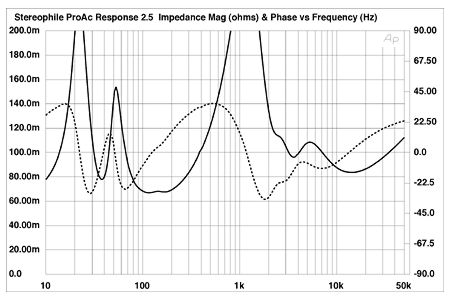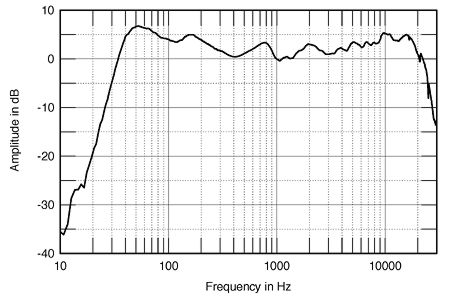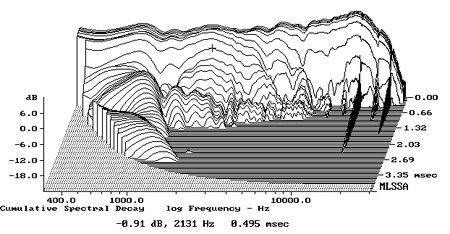| Columns Retired Columns & Blogs |
ProAc Response 2.5 loudspeaker Measurements
Sidebar 2: Measurements
You don't get something for nothing, and the price to be paid for the Response 2.5's impressive bass extension is a low sensitivity: I calculated 2.83V to raise just 83dB (B-weighted) at 1m, which is hardly more sensitive than an LS3/5a! The speaker is easy on the partnering amplifier, however, as its impedance (fig.1) only drops below 8 ohms in the lower midrange, and then not by much. The tuning of the 2.5's reflex port is revealed by the impedance "saddle" at 38Hz in this graph.

Fig.1 ProAc Response 2.5, electrical impedance (solid) and phase (dashed) (2 ohms/vertical div.).
Looking at the responses of the individual drive-units and the port (fig.2), the Response 2.5 appears to be almost a textbook two-way design. Both drive-units are basically flat-balanced in their operating ranges. The woofer hands over to the port below 60Hz and to the tweeter above 3kHz, rolling off smoothly out of its passband. The only blemish is the peakiness in the port output in the upper midrange, but this will have minimal subjective effect due to the fact that the port faces to the speaker's rear. The port's output is otherwise centered on the tuning frequency close to 40Hz and looks high in level. I rechecked this result and, yes, the maximum port output is as strong as that of the woofer.

Fig.2 ProAc Response 2.5, acoustic crossover on tweeter axis at 50", corrected for microphone response, with nearfield woofer and port responses plotted below 300Hz, and 2.5kHz, respectively.
The result, as can be seen from fig.3, is a low-frequency response that's both generous in overall level and well-extended. The anechoic –6dB point, referred to the level at 1kHz, is an excellent 30Hz, with a sharp, 24dB/octave rollout below that frequency. In-room, boundary effects will give some boost, as indeed MF found.

Fig.3 ProAc Response 2.5, anechoic response on tweeter axis at 50", averaged across 30º horizontal window and corrected for microphone response, with complex sum of nearfield woofer and port responses plotted below 300Hz.
The overall response on the tweeter axis—this 37" from the floor, which is an optimal listening height—is smooth, though the midrange is a little recessed compared with the bass and treble. However, this type of balance has always sounded "natural," the slight energy excesses at the extremes balancing each other. The lack of midrange energy that MF noted in his room was almost certainly due to boundary effects. With its woofer mounted quite a long way from the floor, the ProAc 2.5 will need extra care taken in setup to avoid this effect becoming subjectively bothersome.
Despite its use of a relatively large-diameter woofer, the Response 2.5's lateral dispersion (fig.4) is well-maintained through the low treble. Yes, the output does drop off at the top of the woofer's passband at extreme off-axis angles, but this is to a much lesser extent than with other speakers (see the measurements accompanying J. Gordon Holt's KEF THX review for a typically poor example). And in the top two octaves, the Response 2.5's output rolls off smoothly with increasing off-axis angle in a textbook manner. Vertically (not shown), the ProAc 2.5's balance doesn't change appreciably as long as you sit with your ears between the top of the woofer and the top of the cabinet, a range of 26"–41" from the floor.

Fig.4 ProAc Response 2.5, horizontal response family at 50", normalized to response on tweeter axis, from back to front: differences in response 90º–5º off-axis on tweeter side of baffle; reference response; differences in response 5º–90º off-axis on woofer side of baffle.
In the time domain, the step response (fig.5) reveals the tweeter's negative-polarity output to precede the positive-polarity woofer's. The associated waterfall plot (fig.6) features a very clean decay of the sound, with an absence of any resonant modes. Overall, this is excellent measured performance; I'm not surprised MF was so impressed by the ProAc Response 2.5. In my own auditioning, I was also impressed by the ProAc, particularly by its remarkably smooth-sounding midrange and treble.—John Atkinson

Fig.5 ProAc Response 2.5, step response on tweeter axis at 50" (5ms time window, 30kHz bandwidth).

Fig.6 ProAc Response 2.5, cumulative spectral-decay plot at 50" (0.15ms risetime).
- Log in or register to post comments




































